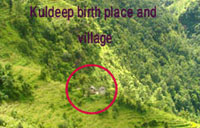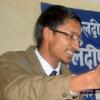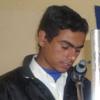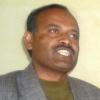कुलदीपको साहित्यहरू / Kuldeep's Literature
कविता
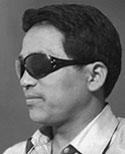
(स्व.कुलदीप सुनुवार)
आज सबै नजर वन्दछन्
आज सबै नजर वन्दछन
द्धारहरु खुला छैनन
कामदारहरु फूर्सदमा छन
अहो कस्तो समय ?
कराईमा पून्यू घोटेर खानेहरु
सिङ्गो कराई खाँन खोज्दैछन
कचोरामा थापेर खाँनेहरु
अनायास कचौरा नै खाँन खोज्दैछन
अहो कस्तो समय ?
कराईको आफनो चाहानाले
कचौराको अस्तित्व छैन यहाँ
त्यस्तै भनौ
कचौराको आफनो चाहानाले गर्दा
कराईको अस्तित्व छैन यहाँ
त्यस्तै भनौ
यहाँ कराई र कचौरा माथी
समय अडेको छ
अहो कस्तो समय ?
कराई र कचौरा माथी अत्यचार भएकोछ ।
-OOO-
Critical Analysis
Glancing on Hongkong Ma Kabita
·Oedipus (Kuldeep Sunuwar)
Poetic genre is the part of literature that gives wide meaning through limited combination of the words. In this sense, poem is the best genre in order to express more ideas through few words. There are various definitions regarding poem, but the much accepted definition is - poem is the genre of literature which represents cultural, political and social phenomena of the society. For example - the poems written in "Hongkong Ma Kabita" attempt to stress upon Nepal's current political situation.
In addition, every poem reflects the poet's patriotic feelings towards his nation and his individual pathos. Hongkong Ma Kabita is the most important anthological collection not only among Diasporas but also the best book in the context of Nepalese literary scenario. The most important characteristic feature of the poem is its poetic devices and figurative language.
There is decorum of figurative languages in the poem. The figurative language is the best entity of the poetic genre in order to achieve some effect by the audience. So the book is written on the basis of pragmatic criticism. It is also well known that the most modern classifications and analysis are based on the treatment of figurative language by Aristotle and some Rhetoricians. In Hongkong Ma Kabita, there are poems that keeps hankering the reader, once the reader gets its taste. It's a sort of volume meant for thumbing through the perfect companion to a peaceful moment when reader can just curl- up and enjoy a sort of poetic oasis in our hurry up- and- go- society. That is why Hongkong Ma Kabita is trying to be fairly expensive in the section because of its solid job of assembling a variety of voices and styles.
Another significant quality of Diaspora's anthological poetic collection is that all of the poets use powerful ethnological poetic diction in order to construct pastoral poem applying powerful poetic license. Through the ethnological poetic diction, most of the poets succeed to perceive emotion and passion of the ethnic history. In order to bring- forth the thematic history and religion, they use powerful ethnic characters like- Sumnima and Paruhang (Goddess and God of Kirat religion). Hongkong ma kavita is the book including fifty- six poems of the thirteen poets in Hongkong. The book is published by Srijansil Sahitya Samaj Hongkong. All the writers included in this collection are established poets in Nepal. I have endeavored to analyze briefly, each poem of this collection called Hongkong Ma Kabita are extracted from the anthological collection called Hongkong Ma Kabita.
Poet Prakash K.C's 'Hongkong Bhitra Ko Mero Nepal' attempts to show the reality of Nepalese mini society in Hongkong. The specific characteristic feature of his poem is the way of using poetic devices like simile and linguistic metonymy. He wants to show the double meaning in a sentence- on the one hand he compares mini Nepal with 'semen' inside the condom, on the other hand he wants to give large meaning of Nepal through small entity 'semen'. Here, 'semen' indicates Nepal and condom to Hongkong. The metonymic idea reflects the condition of Nepalese people in Hongkong. The poet says Nepali people are enjoying exploitation, suppression and oppression within mini Nepal in Hongkong.
Poet Tanka Sambahamphe's 'Kumari Prahaha' brings poetic device- simile by comparing his own life with the eminent existentialist character Sisyphus. He does many attempts like Sisyphus but he gets nothing except vagueness and suffering. So the poem verges on the theory of existentialism. The theory of existentialism describes about eternal attempt in life and choice. Regarding life, the prominent novelist Earnest Hemingway says,' life can be destroyed but never defeated'. So life is the chain of eternal progress where there is no stoppage. In the same manner, existentialists say, ' life exists in choice'. This means that there is no option in life without out of choice. Not choosing is also a choice. Sisyphus strives to create the meaning out of meaningless by continuously lifting the stone. So does the poet in this poem. That is why, choice and existence are inextricably linked. So, the poem is closer to the theory of existentialism.
Poet Ganesh Rai's 'Blair Mo Yuddha Ma Chhu' points to the colonial- activities around the world including Nepali British- Gurkhas Army. The poet seems unhappy toward colonial behavior. The poet gives lot of instances that Nepalese soldiers have done very well job to establish colonialism around the world. In this context, he tries to recall so many great deeds by the Nepalese soldiers in Borneo and Malaya in World War II. The poet says in return, unfortunately, British government rewarded Nepalese British Gurkhas - Army with the medal of ignorance and negligence. According to the poet this is the total devaluation of Nepalese labour in the name of human rights. That is why the poet Ganesh Rai is directly pointing to the earlier British Prime Minister Tony Blair in his poem.
Poet Bhogen Akle's 'Sathi Lai Chitthi' is a letter to his friend from Hongkong who lives in Nepal describing social phenomena of Chinese society which based is blended with Nepalese society in Hongkong society in Hongkong. In the poet's observation, he does not find good Nepalese culture except fragmentation, disintegration and dissipation due to the effect of ultramodern and postmodern society in Hongkong. Nothing is absolute, everything is fluid in the society according to postmodernism. The poet is pessimistic with the Nepalese society since people are going to forget their own history blending in the culture and society of Hongkong.
Poet Chandra Sambahamphe's 'Aksher ko mulya' argues about letter' euphoria by giving personification to the letters. Among many poetic devices, personification is the best device. It gives life sense to the non- living things. In ordinary language, euphoria is applied only for the living things but by using the poetic license, the poet subverts the rules of ordinary language- then the poet applies poetic devices called personification by giving animate quality to the inanimate things. This is the most important idea in order to drag attention of the audience. Russian formalists have named ' poetic grammar' to this idea.
Poet Nanda Ghale's 'Yautai Aasa Ma Bacheko Chhu' seems anti- natural because he is opposite of the nature. The poet does not like to see the sun setting in the west; he never likes to be old. He wants to remain young forever. The poet looks very opposite and seems non- conformist over the nature. The idea seems quite strange, which is the most important characteristic feature of the poem to capture the audience's mind. In so doing, the poet drags attentions of the poet. The poet prefers change in every field. So, the poet says that the daily activities also need to be changed in opposite manner which is impossible. So, the poem is written on the basis of pragmatic criticism. In this sense, the poet always wants to see creativity and dynamicity in the society. He rejects static quality of the society.
Poet Himkala Rai's title 'Cheli Ko Anurodh' is an earnest request to male. Of course, Rai's poem sings pathetic melancholy of the marginalized woman of the male dominated Nepalese society. The most significant thing about her poem is that the poet shows three types of characters regarding mythology and geography. Those are mythological ideal character- Sita, geographically highest mountain- Mt Everest and the symbol of non- violence- Buddha.
These three characters are powerful poetic diction that indicates feminism by Sita; Geography- Mt Everest and peace angle- Buddha. But the poet Himkala Rai never gives straight meaning of their significance. The poet throws irony over male dominated society through these powerful characters in order to show her poetic justice. The poet also wants to make bitter attack upon ideology of Nepalese society's false statement over female. Nepalese society characterizes women as Sita, Parbiti, and Laxmi ( symbol of Goddesses) and so on, but merely in the theoretical aspect.
Poet Desh Subba has written cozy poem which gives broad meaning with limited words. His poem's title 'Narak' or 'Hell' describes earlier monolithic minority government's nature in brief. In context, the poet wants to demonstrate reality of tyrannical King's rule Nepal. In order to show the negative reality of the ruling system, he brings three negative words like- totalitarianism, claw and hell which portray destruction, demolition and corruption. In this poem, the poet wants to convey that arrogance leads toward destruction instead of construction which is very closer to the tyrannical King's monolithic system in Nepal. Totalitarianism has good wings, claws and legs but it flies toward hell. So, there is no meaning of growing claws, legs and wings which are closer to the Icarus, the proudy character of a mythical story. The poet finally succeeded to convey the political reality through powerful negative poetic diction in his poem 'Narak'. This is the objective picture of the Nepal during the period of monarchical system in Nepal.
Poet Narayan Ratanchhali (title-Hamro Bidroha) has specific type of writing style in his poem. The specific style in the sense that he has written this poem from the first person point of view (I). In this poem, from and content have very special meaning among- 'I' 'You' and 'We'. Here 'I' refers to the poet himself but 'You' refers to the nation. The poet represents people. Then, there is conversation between people and the nation. But the nation is the passive listener. The poet always finds himself opposite to the nation. The nation never obeys the intention of the poet. They never agree with each other. Therefore, there isn't good relationship between the poet and the nation.
Regarding this two characters, they always go throughout disagreement in every opinion. Through this idea, the poet wants to reveal the reality of the nation. But finally the poet shows a good union between them through a character by ' We'.
Poet Pradip Kandanwa's title 'Aahak Thuk Chhya' attacks the ruling people with the help of powerful ethnological poetic diction. So, it is very easy to identify that this poem is about domination, exploitation and oppression over the certain community. The poet must indicate towards the condition the marginalized community which is suppressed by the high class people. But the poet denies bearing domination and exploitation rather he likes to retaliate the challenge against them. The poet directly speaks language of indigenous community. The character Eklavya stands for indigenous character, who is ready to sacrifice his thumb for the sake of his teacher as a loyal disciple. Here, the teacher stands for high class character of the nation. The teacher deliberately asks his thumb because Eklavya was very skilful to play with the bow. This is the symbol of hatred to the people who is in the power through the character of the teacher. This poem has been written on the basis of one of one of the mythical story of Hinduism.
Poet Kala Rai's title 'Abahan Uni Haru Lai' wants to appeal her male colleagues. The poet has heavy pathos upon male domination. The poet is unhappy with male's submissive domination to the female which is intolerable for the poet. There is also poetic device called simile in which the poet compares woman with roads in the sense of domination and suppression. She gives poetic justice by allocating ethological characters like Toma, Simma, Paruhang and Sumnima.
Poet Agyat's 'Machinde' stresses over the powerful symbol palace. Among several devices, symbolism is also one of the most important devices in this poem. The poet uses palace as a dominant symbol. The palace stands for constitutional monarchy and feudalism in Nepal. Here, the poet is melancholic due to the sight of the palace and he being standing like it. In this period, people condemn palace because monarchy system has been trapping several marginalized people in Nepal for two hundred and thirty seven years. Therefore, the poet is fade- up with his standing life like palace' He finds himself in similitude with the monarchy that he largely detests. His life is compared with feudalism which is a matter of burden for Nepal. In his opinion, the state of his own life and activity of feudalism are similar. This means that he dislike condition of his own life as well as feudalism. Feudalism is such kind of ruling system that has been suppressing emotional will of freedom. This freedom is freedom of humanity and individual. But this kind of freedom of humanity has been killed. Killing humanity means killing freedom that has been done by monarchical system in Nepal.
Like palace, the tower is also another most important symbol in this poem. The tower is significant in the sense that it represents post-modernist activities. Post- modernist activity is less conducive for human beings because man should perform their work like machine. In this regard, people have lost their humanity and they have been changing themselves into machine. The poet is not far away from such post- modernist conditions. He has to stand during the entire period of his duty to erk- out for his existence. According to his expression, he has been working in modern office somewhere else. The poet is dissatisfied with his hackneyed life and is entirely desperate since humanity and society is controlled by industrialists. This is the city of industrialization that he has been living. With the consequence of the post- modern life, hr expresses his anger by using Nepali significant obscene word- 'MACHINDE'. By his expression, he seems much angry with post- modern life and feudalism. This expression is entire revelation of his inner feelings of psychologically furious state. He has no other option except expressing 'MACHINDE'. He is furious with present condition of post- modernism and feudalism at all. His expression of 'MACHINDE' and the English poet, e.e. Cumming's ' FUCKING' (I sing of Olaf glad and big) are similar. But e.e. Cumming is disgusted with his army commander whereas the poet, Hangyug Agyat is vexed with present state of society. Modern people are suffering from double jeopardy- on the one hand, they are exploited by feudalism and on the other hand, they are marred by postmodernist machine like money- oriented industrialist activity. This is the major theme of this poem.
Unlike poet Agyat, the poet Naresh Sunuwar's 'Hongkong Ko Mausam' stresses over Hongkong society by using powerful device called metaphor. Here, the poet uses weather as a metaphor in order to indicate social condition within Hongkong. The poet focuses upon the specific Nepalese society. He worries about Nepalese society because it is beyond limitation and makes parallel comparison to the condition of Hongkong society with the crows that are disappearing in the cloud. This is also one of the most important poetic devices called simile in order to portray the chaos and disorder of Nepalese social activities in Hongkong. He also says that Nepalese are losing themselves inside the deep sea like giggle of goose having no swimming ability because they forgot to swim in the sea. They are beyond restriction like freedom of bull. The bull is such an animal which is very strong and difficult to bring in track. The society is likely to be made by the machine and the robot not by the people. In this sense, the poet wants to say that they lose culture, history as well as humanity in the robot like society. They crush their thinking tanks, principles and existence of life into the blazing fire with the pieces of barbecues.
Like metaphor, the poet uses the most important poetic device called personification. The poet personifies the big mansion by giving human attribute because the mansion laughs at the people who give big talk around the city. This act also carries the meaning of postmodernism because there is no limitation. In other words, nothing is impossible. The postmodernism believes in uncertainly, possibility, indeterminacy, multiplicity and diversity. It always subvert center and disseminates hierarchy, and gives importance to the margin.
Finally, 'Hongkong Ma Kabita' is the book like melting pot where there is everything inside it. Blending multiple ideas is the essential quality of this book. By reading this book, I rose with feeling of light spreading across the water.
Master's Degree program in English
Kathmandu Model College

